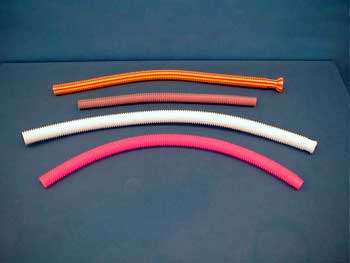Demos: 4B-14 Whirly Tubes

A flexible corrugated tube is held at one end and whirled rapidly. At selected whirling speeds, resonant tones appear and switch to higher frequencies in “jumps” as the whirling speed is increased. The jumps, in fact, produce a 1-3-5-8 arpeggio.
Directions: Grab the tube at one end and whirl the other end fairly rapidly. At low speeds you will hear a low tone. As the speed is increased, the sounds will jump to the next note in the 1-3-5-8 sequence. To achieve the upper notes, you will have to whirl the tube very rapidly.
To show that air is in fact passing through the tube, hold your other hand against the bottom of the tube, closing the opening. Whirling the tube produces no sound. To further illustrate this effect, place small pieces of paper in your hand. As you whirl the tube, hold the lower end near the palm of your hand. The paper will be sucked right up through the tube!
Suggestions for Presentation: You can be a little bit of a showman here. Play tunes, like “Taps.” After you’ve achieved the highest note you can (by whirling it really fast), ask if they want to hear you play the notes still higher. Climb on a chair and do it again!
The conventional wisdom has it that the phenomenon is produced by the Bernoulli effect. Frank Crawford years ago performed a series of classic experiments (written up in a 70’s article in The American Journal of Physics) showing that the sound is really a set of “bump frequencies” that result from the air passing over the corrugations. And the reason the air flows up the tube is the “centrifugal” effect of rotating a column of air.)
Vacuum cleaner hoses will not work because the corrugations are in fact spiral rather than a succession of circles. If you really want to be dramatic, ask the lecture-demo technician to find our set of large corrugated black plastic sewer pipes. The frequencies, as you might guess, are considerably lower.
Applications: Resonances in pipes.
Last Updated: Nov 30, 2023 11:25 AM